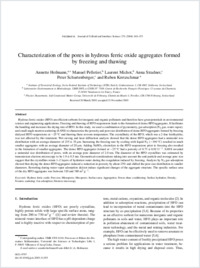Characterization of the pores in hydrous ferric oxide aggregates formed by freezing and thawing
- Hofmann, Annette Institute of Terrestrial Ecology, Swiss Federal Institute of Technology (ETH) Zurich, Schlieren, Switzerland
- Pelletier, Manuel Laboratoire Environnement et Minéralurgie, UMR INPL et CNRS, Centre de Recherche François Fiessinger, Vandoeuvre les Nancy, France
- Michot, Laurent Laboratoire Environnement et Minéralurgie, UMR INPL et CNRS, Centre de Recherche François Fiessinger, Vandoeuvre les Nancy, France
- Stradner, Anna Soft Condensed Matter Group, Physics Department, University of Fribourg, Switzerland
- Schurtenberger, Peter Soft Condensed Matter Group, Physics Department, University of Fribourg, Switzerland
- Kretzschmar, Ruben Institute of Terrestrial Ecology, Swiss Federal Institute of Technology (ETH) Zurich, Schlieren, Switzerland
-
18.01.2004
Published in:
- Journal of Colloid and Interface Science. - 2004, vol. 271, no. 1, p. 163-173
hydrous ferric oxide
pore size
micropores
mesopores
surface area
aggregation
freeze–thaw conditioning
surface hydration
density
neutron scattering
gas adsorption
electron microscopy
English
Hydrous ferric oxides (HFO) are efficient sorbents for inorganic and organic pollutants and therefore have great potentials in environmental science and engineering applications. Freezing and thawing of HFO suspensions leads to the formation of dense HFO aggregates. It facilitates the handling and increases the drying rate of HFO. In this study, we used a combination of pycnometry, gas adsorption (N2 gas, water vapor), and small-angle neutron scattering (SANS) to characterize the porosity and pore size distribution of dense HFO aggregates formed by freezing dialyzed HFO suspensions at −25 °C and thawing them at room temperature. The crystallinity of the HFO, which was a 2-line ferrihydrite, was not affected by this treatment. Wet sieving and laser diffraction analysis showed that the dense HFO aggregates had a unimodal size distribution with an average diameter of 235±35 µm. Increasing the freezing rate by cooling with liquid N2 (−196 °C) resulted in much smaller aggregates with an average diameter of 20 µm. Adding NaNO3 electrolyte to the HFO suspensions prior to freezing also resulted in the formation of smaller aggregates. The dense HFO aggregates formed at −25 °C had a porosity of 0.73±0.02 l l−1. SANS revealed a unimodal size distribution of pores, with an average pore diameter of 2.0 nm. The diameter of the HFO crystallites was estimated by transmission electron microscopy to be 1.9±0.5 nm. Geometrical considerations taking into account the unit particle and average pore size suggest that the crystallites retain 1–2 layers of hydration water during the coagulation induced by freezing. Analysis by N2 gas adsorption showed that drying the dense HFO aggregates induced a reduction in porosity by about 25% and shifted the pore size distribution to smaller diameters. Rewetting during water vapor adsorption did not induce significant changes of the aggregate structure. The specific surface area of the dry HFO aggregates was between 320 and 380 m2 g−1.
- Faculty
- Faculté des sciences et de médecine
- Department
- Département de Physique
- Language
-
- English
- Classification
- Physics
- License
- License undefined
- Identifiers
-
- RERO DOC 4181
- DOI 10.1016/j.jcis.2003.11.053
- Persistent URL
- https://folia.unifr.ch/unifr/documents/299762
Statistics
Document views: 135
File downloads:
- 1_schurtenberger_cph.pdf: 410
